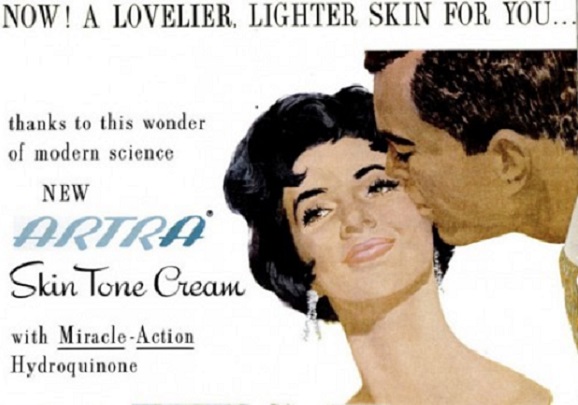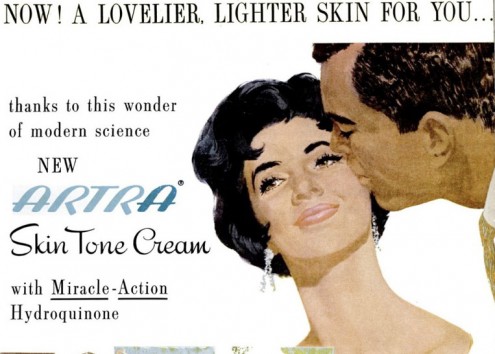The Global Phenomenon of Skin Bleaching A Crisis in Public Health (Part 1)
Main Article Content
Abstract
The global issue of skin bleaching or lightening has become a public health crisis of epic proportions. Many people of color purchase and use skin bleaching products that later cause skin discoloration, skin cancer and other medical problems. Due to the depth of this phenomenon, I will devote a two part series to this issue in order to explore the ethical and public health challenges involved in skin bleaching, especially involving people of color. The issue of skin bleaching is more dangerous and deadly for people of color throughout the world because the practice also affects psychological and physical faculties.
The psychological impact for many people of color to lighten one’s skin in order to fit within the larger society’s definition of beauty is now more widespread than ever. Skin bleaching also symbolizes more complex psychological issues such as self-perception and self-esteem that have plagued people of color since the advent of international slavery, especially in the Americas. For instance, African-Americans are often coerced through the mass media to believe that lightening one’s skin through bleaching or lightening products brings greater acceptance into the larger North American society. But I believe coercion can be most effective unconsciously through culturally assimilative brainwashing, which may have a deeper impact on one’s consciousness to choose collective acceptance by the general society rather than individuality based upon positive views of self and one’s own ethnic origins.
One of the most recent examples of coercive means to brainwash Africans throughout the West African Diaspora is most visible in the phenomenon of bleaching one’s skin in order for it to be lighter. This phenomenon has been described as medically risky and psychologically dangerous. Recent news reports throughout West and South Africa’s media have reported about black women who buy skin whitening products in order bleach their skin tone to look whiter and, in their opinion, more beautiful. Although many African women may not view their actions as medically dangerous, numerous medical studies have already indicated that excessive usage of these skin whitening products can have an adverse effect that may cause skin cancer. Some African nations have even considered limiting the sale of skin whitening products due to the mass and, sometimes, excessive usage of these products by black women.
When interviewed by news outlets, many African women have expressed that media images portraying white women as beautiful greatly influenced their decision to whiten their own skin. Furthermore, these women have added that although skin whitening products may have harmful effects, they would still use these products to look and feel more beautiful.1 One has to wonder whether such a mass consumption of these products will eventually cause a self-induced public health crisis within a segment of the larger global population. The reality is that without the conscious awareness of the negative impact of some coercive measures and a strengthening of one’s individual identity, those who are faced with similar issues will not be able to overcome similar challenges.
The ethical issue involved in skin bleaching is that many skin bleaching products cause great harm to customers due to high levels of mercury. Thus, many customers who buy these products are endangering the health of their skin, while skin care product companies continue to benefit financially from selling these products. In many instances, customers are uninformed about the medical risks involved in consuming excess amounts of skin lightening creams such as Artra. This product, in particular, is globally advertised to encourage women of color to purchase it in order to have lighter and more beautiful skin, according to popular standards of beauty.
Some critics may point out that people of color who choose to purchase and use skin bleaching products in excess are responsible for their own health risks. But as I see it, when a minority or vulnerable population consumes an excess amount of skin lightening products, a significant global health care phenomenon is at risk of causing physical harm and life-altering health problems to people who otherwise would not face these challenges.
According to the World Health Organization (WHO), mercury is a common ingredient found in skin lightening soaps and creams. 2 Although skin bleaching products are hazardous to one’s health and banned in many countries, these products are available for sale over the internet, providing unlimited access to potential customers. For example, in Mali, Nigeria, Senegal, South Africa and Togo, 25%, 77%, 27%, 35% and 59% of women, respectively, are reported to use skin lightening products on a regular basis.3 In 2004, nearly 40% of women surveyed in China (Province of Taiwan and Hong Kong Special Administrative Region), Malaysia, the Philippines and the Republic of Korea reported using skin lighteners.3
The most dangerous effect of the inorganic mercury contained in skin lightening soaps and creams is kidney damage.2 Mercury in these products may also cause physical reactions such as scarring, reduction in the skin’s resistance to bacterial and fungal infections, and also psychological outcomes such as anxiety, depression or psychosis, and peripheral neuropathy. 3-5
More attention needs to be focused on restricting the sale of internet skin lightening products containing mercury because people of color, especially women, are dramatically being affected by exposure to these products. For instance, mercury in soaps, creams and other cosmetic products is eventually discharged into waste water. The mercury then enters the environment, where it becomes methylated and enters the food-chain as the highly toxic methylmercury in fish. Pregnant women who consume fish containing methylmercury transfer the mercury to their fetuses, which can later result in neurodevelopmental deficits in the children.4
Unfortunately, a generation of women is negatively being affected by excess usage of these products and in many instances the environment, including the water supply and food chain, is dramatically being affected in countries where people of color live and consume skin bleaching products. Therefore, it is reasonable to conclude that skin lightening products have caused a silent, but deadly epidemic in public health that needs to be addressed immediately. Although customers have the choice to purchase these products, the larger population is being affected health wise. As bioethicists, it is our utmost responsibility to protect the larger population than to protect individual rights to purchase skin bleaching products that contain mercury.
Ethical guidelines should be recommended by bioethicists to limit companies from selling skin lightening products on the internet. These universal guidelines can be implemented by monitoring skin care product websites and even restricting how many products a customer may purchase over a period of time. Such limits are only a first step in counteracting a systemic problem in public health. A collective effort should be initiated by bioethicists and public health officials globally to prevent companies from gaining high profits while harming the health of their customers. It will entail the international cooperation of health officials who can recommend ethical solutions to protect our citizens, especially vulnerable groups such as women of color.
Education is one of the most effective ways to inform the general public about the hazards of skin lightening products that contain mercury. Public service campaigns-through television, billboards, and the internet-can inform customers about how the risks of consuming these products affect personal health, the general public, and our environment. Such awareness provides customers with the necessary public health information to make reasonable health care decisions.
In part two of my next opinion editorial, I will briefly highlight how some international celebrities of color such as Sammy Sosa have been consumers of skin bleaching products, only to negatively influence the general public’s interest in buying these hazardous products. Their actions are also reflective of a larger psychological, physical, and global trend in attempting to lighten one’s skin in order to gain acceptance by the ruling class. As a result, many people of color in nations such as Brazil and Nigeria have consciously and subconsciously equated beauty with whiteness. This trend is due, in large part, to the negative impact of European colonialism, which encouraged a divide-and-conquer mentality based on social classism, colorism, and racism.
Globally, women of color have also been increasingly consuming these skin bleaching products that contain mercury because they unfortunately believe that their dark or brown skin is somehow unattractive or ugly. I plan to also argue that additional ethical and public health measures, based on psychological and educational dimensions, should be explored in order to decrease the usage of skin lightening products containing mercury. In many instances, the general public is unaware of the role melanin plays in intelligence and soulfulness. Therefore, I will also explore how awareness of the power of melanin and race consciousness could help dispel the myth that whiteness or lighter skin equates beauty and intelligence. In my opinion, such awareness could possibly reduce the public health phenomenon of skin bleaching.
PART II
REFERENCE NOTES Part 1
1. Nigerians in America (2013). New survey says Nigerian women lead in skin bleaching.
Retrieved from http://cultureshocknigerians.com/news/new-survey-says-nigerian-women-
lead-in-skin bleaching/#sthash.c9yf9i5Y.dpuf
2. World Health Organization (2011). Mercury in skin lightening products.
3. UNEP (2008). Mercury in products and wastes. Geneva, United Nations Environment Programme,
Division of Technology, Industry and Economics, Chemicals Branch
(http://www.unep.org/hazardoussubstances/LinkClick.aspx?fileticket=atOtPM-
tTmU%3d&tabid=4022&language=en-US).
4. Glahder CM, Appel PWU, Asmund G (1999). Mercury in soap in Tanzania. Copenhagen, Ministry of
Environment and Energy, National Environmental Research Institute (NERI Technical Report No. 306;
http://www2.dmu.dk/1_viden/2_publikationer/3_fagrapporter/rapporter/fr306.pdf).
5. Ladizinski B, Mistry N, Kundu RV (2011). Widespread use of toxic skin lightening compounds:
medical and psychosocial aspects. Dermatologic Clinics, 29:111–123.
Article Details

This work is licensed under a Creative Commons Attribution 4.0 International License.


